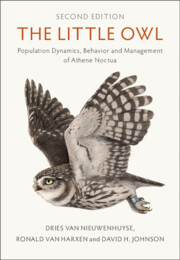Book contents
- The Little Owl
- The Little Owl
- Copyright page
- Contents
- Foreword
- Preface
- Acknowledgements
- Executive Summary
- Chapter 1 Introduction: Framework
- Chapter 2 History and Traditions
- Chapter 3 Fossil Evidence, Taxonomy and Genetics
- Chapter 4 Morphology and Body Characteristics
- Chapter 5 Distribution, Population Estimates and Trends
- Chapter 6 Habitat
- Chapter 7 Diet
- Chapter 8 Breeding Season
- Chapter 9 Behavior
- Chapter 10 Population Regulation
- Chapter 11 Management and Conservation
- Chapter 12 Research Priorities
- References
- Index
Chapter 2 - History and Traditions
Published online by Cambridge University Press: 29 September 2023
- The Little Owl
- The Little Owl
- Copyright page
- Contents
- Foreword
- Preface
- Acknowledgements
- Executive Summary
- Chapter 1 Introduction: Framework
- Chapter 2 History and Traditions
- Chapter 3 Fossil Evidence, Taxonomy and Genetics
- Chapter 4 Morphology and Body Characteristics
- Chapter 5 Distribution, Population Estimates and Trends
- Chapter 6 Habitat
- Chapter 7 Diet
- Chapter 8 Breeding Season
- Chapter 9 Behavior
- Chapter 10 Population Regulation
- Chapter 11 Management and Conservation
- Chapter 12 Research Priorities
- References
- Index
Summary
With its large distributional range across Europe, the Middle East, and Asia, and an ability to co-exist as a commensal with many human habitations, not surprisingly, the Little Owl has figured prominently in many cultural beliefs, and in a variety of ways. The common names given to this species across the countries are linked to its activity, to its voice, to its morphology, to its food, to beliefs, to its habitat, and to mythology. In Greek mythology, Athena was the daughter of Zeus and originally a Mycenaean palace goddess, guardian of cities, war goddess, patroness of arts and crafts, and promoter of wisdom. A particularly interesting example of the cultural use of Little Owls comes from Crespina, Italy, which was a center for the rearing of owls in captivity to be used for hunting small passerines. They were sold at the Little Owl market while tied up on a roost. The nobility (upper-class people) commonly hunted in the countryside using the Little Owls as bait. The history and traditions of the Little Owl are truly long, rich and varied, and grow with additional recoveries of artefacts from archaeological sites, as well as evolving cultural views. In closing this chapter, we urge reviewers of owl myths, traditions and lore to closely scrutinize the information they assemble, to determine whether the ideas and symbolism described in text and artefacts still apply in contemporary societies, or whether they are part of the colorful but quaint past.
Keywords
- Type
- Chapter
- Information
- The Little OwlPopulation Dynamics, Behavior and Management of <I>Athene noctua</I>, pp. 9 - 19Publisher: Cambridge University PressPrint publication year: 2023

